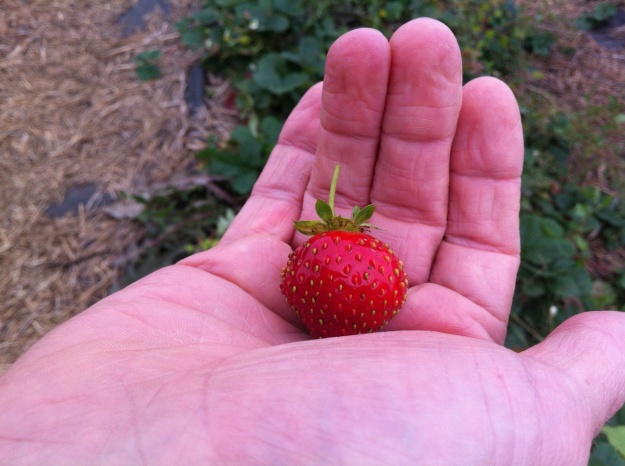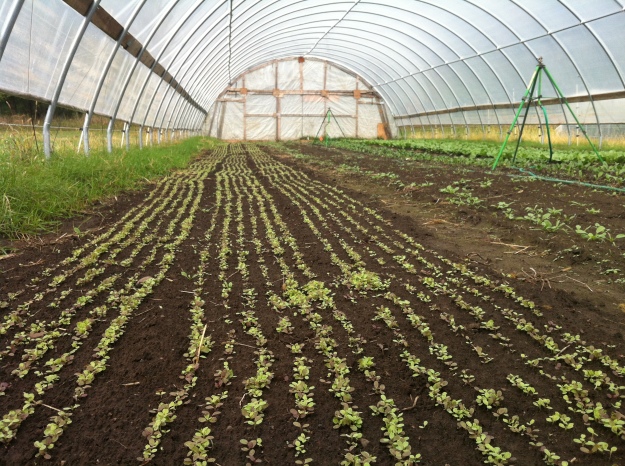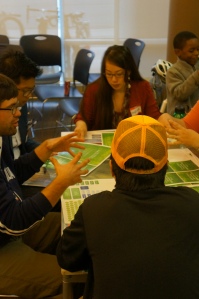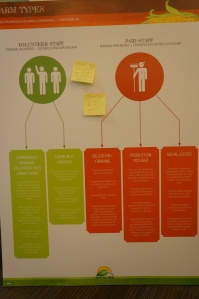On Sunday the design team (all of us!) met on the site of Frogtown Farm for a working meeting to discuss layout and site design. It was an especially productive session, with time to check in with City of Saint Paul Parks & Rec Landscape Architect Kathleen Anglo, as wells as Frogtown Farm Board member Seitu Jones. The designers walked the site to determine ideal path and access points, noting the slopes of the topography, and taking soil plugs periodically to assess depth of the top soil (it varies considerably).
Monthly Archives: October 2013
Designers visit MN farms for inspiration
Team designers Blaine Merker and John Bela (along with John’s brother Paul, a farmer in Kentucky) spent the day after the October 12th Community Design Workshop touring local farms for inspiration and lessons to bring to Frogtown Farm.
First stop was the University of Minnesota student demonstration garden, run by design team member Courtney Tchida. While the season was done and had left just a few tomatoes clinging to the vine (as frost still lingered in the furrows), there were a few tasty strawberries still to be had.
Later that day, we drove out to Big River Farms just by the Wisconsin border. Big River has an interesting model: there is a large production field and hoop houses for the CSA they run, as well as training plots for immigrants who are learning to farm, who can also contribute to the CSA’s produce. The farm manager helps train the immigrant farmers, each of whom may be in a different phase of expertise and entrepreneurship around farming.
Managing new farmers to produce goods for a CSA is difficult business, but as the farmers become more experienced, they are able to commit to producing more and more for the CSA. Setting prices, proper handling and washing of the produce, as well as marketing are all areas that Big River helps train these new farmers in. After a year or so at Big River, the new farmers go on to farm their own plots.
October Public Workshop is a hands-on design experience!
On Saturday, Oct. 12th, the design team presented background research and design examples at the Rondo Library to gather community feedback on the design directions and programs possible for the Farm. Check out our summary and image of the display boards in the “Meeting Record” section of the blog.
More images below:
Recap from October public workshop
We had a productive and successful design workshop with a great turnout from the community! We brainstormed about the layout of Frogtown Farm and which services and programs it will provide. Look below to see the boards where we collected community feedback, concerns, questions, aspirations, and desires.
Yields
The “Yields” board was intended to gauge where community support lay for different focuses of Frogtown Farm. Participants were asked to select their top three choices to account for the fact farm yields can overlap and accomplish multiple tasks. The community’s top focus for Frogtown Farm was Youth Empowerment and Education with Job Training and Education and Community Ties close second and third choices, respectively.
What do you think?
The “What you you think?” board was design to capture the community’s general thought, desires, and concerns about Frogtown Farm. The main desires are to incorporate everyone, especially neighborhood youth, and for the farm to have unique yields, not duplicate work already done in Frogtown.
Menu of programs
The “Menu of programs” board spatially displayed what different services and infrastructure are possible at Frogtown Farm. Frogtown community members envision a multifunctional building that could be a center for food storage, processing, and sales, a meeting for farmers and community members, and potentially an on-site residence for a farmer (and his/her family). The feedback also demonstrated a great inclination towards production and demonstration farm plots rather than space for private community gardens.
Site analysis
The “Site analysis” board displayed the current layout of the entire Frogtown Park and Farm property and mapped out some of the important features of the property that will affect the farm, such as “ag potential, “vegetation,” and “sun and wind.” Feedback on the board was widespread, as many of the voiced concerns, suggestions, and desires were concerned more with the entire property, rather than the farm specifically. The farm specific suggestions ranged from cover crops to compost production to the possibility for animals on the property.
Farm types
The “Farm types” board made graphic the dichotomy between paid and volunteer staff. It also further subdivided the two general categories. Paid staff was broken into education/training, production, and social justice farms, while farms operated by volunteers were separated into community-managed, volunteer-run farms and community gardens. The feedback gathered on the board reiterated the concern about duplicating existing programs and institutions in Frogtown and instead urged Frogtown Farm to be a nexus of existing programs.
Farm organization structures
The “Farm organizational structures” board demonstrated how decisions about Frogtown Farm have and will be made. Much of the feedback discusses what type of organization structure would enable the most efficient and prosperous farm. Process related feedback was directed to questions about how to maximize community engagement (representative of a diverse Frogtown demographic) and where the power of final decisions lay amongst the different organizations involved. Physical concerns about the site focused on access and parking and ensuring safety and security at the Farm.
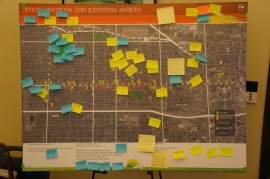
Food systems and existing assets
The “Food systems and existing assets” board documents existing Frogtown businesses and organizations related to food and community development. Workshop participants added important businesses and services previously overlooked to help expand Rebar’s knowledge of the area.
Frogtown getting greener as ‘crazy idea’ puts down roots 
Twin Cities Daily Planet article about Frogtown Park and Farm!
Also, note the community design workshop this Saturday, October 12, 2013.





